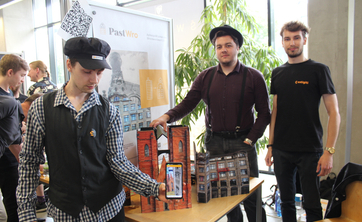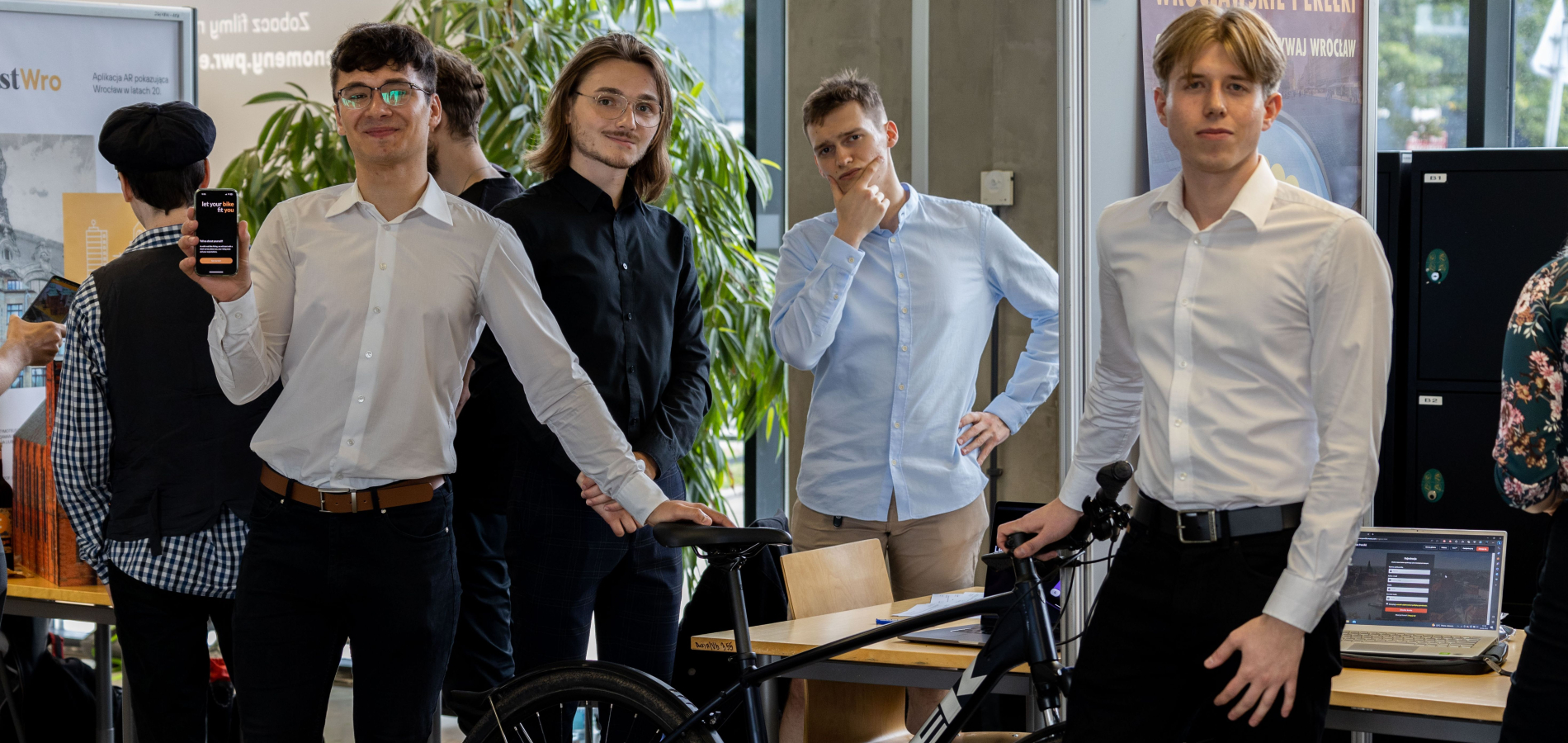
A water monitoring station and thought-controlled augmented reality glasses are the awarded solutions developed by students as part of the 10th edition of the Team Projects Conference. A total of 25 projects were presented in the venue.
 The Team Projects Conference is an initiative in which representatives of companies in various fields and branches of economy propose topics and students carry them out in close cooperation with the companies. As a result, they can see what it's like to work in such enterprises. It is also an opportunity for university employees to make contacts with representatives of the industry, which in the future may result in joint research and development projects.
The Team Projects Conference is an initiative in which representatives of companies in various fields and branches of economy propose topics and students carry them out in close cooperation with the companies. As a result, they can see what it's like to work in such enterprises. It is also an opportunity for university employees to make contacts with representatives of the industry, which in the future may result in joint research and development projects.
The topics are proposed in the winter semester and they are later carried out for 15 weeks of the summer semester. They should be consistent with the study programmes, but the emphasis is primarily on teamwork. Therefore one topic typically involves a group of 4-5 students, in cooperation with companies.
This year, approx. 90 projects were submitted by 30 companies. The 25 most worked-out solutions were displayed during the final gala, which tThis year took place in the C-13 building. The students had to, inter alia, present their idea and demonstrate how it works.
– Students have developed a lot of hardware projects. There are as many as eight of them, and previously we had to persuade them a bit to choose such ideas. The reason is that they are more demanding: finding a working solution is more difficult and they may cause you to ‘stumble’ on them – says Dr. Maciej Nikodem from our Faculty, organizer of the Team Projects Conference. – We are also pleased that the presented solutions are very refined and implemented at a high level – he adds.
Awards from companies
 One such device is a live water quality monitoring station. The project submitted by the company Thaumatec Tech Group was carried out by Jakub Marczak, Hubert Orda, Łukasz Walczak and Paweł Wójcik, students of automation and robotics at the Faculty of Electronics, Photonics and Microsystems.
One such device is a live water quality monitoring station. The project submitted by the company Thaumatec Tech Group was carried out by Jakub Marczak, Hubert Orda, Łukasz Walczak and Paweł Wójcik, students of automation and robotics at the Faculty of Electronics, Photonics and Microsystems.
– The issue of water monitoring has become very important after the disaster that happened on the Odra river, which is why we decided to focus on this topic. Our device is adapted to the monitoring of smaller reservoirs, e.g. ponds or swimming pools. Such solutions probably do not exist on the market yet – says Jakub Marczak.
The floating monitoring station prepared by the students was printed on a 3D printer. It is equipped with a battery and photovoltaic panels as well as all the required sensors. It measures four key parameters for water – temperature, hardness, pH and turbidity, collecting data at specific time intervals. The information is sent via a wi-fi network and displayed in a dedicated application device.
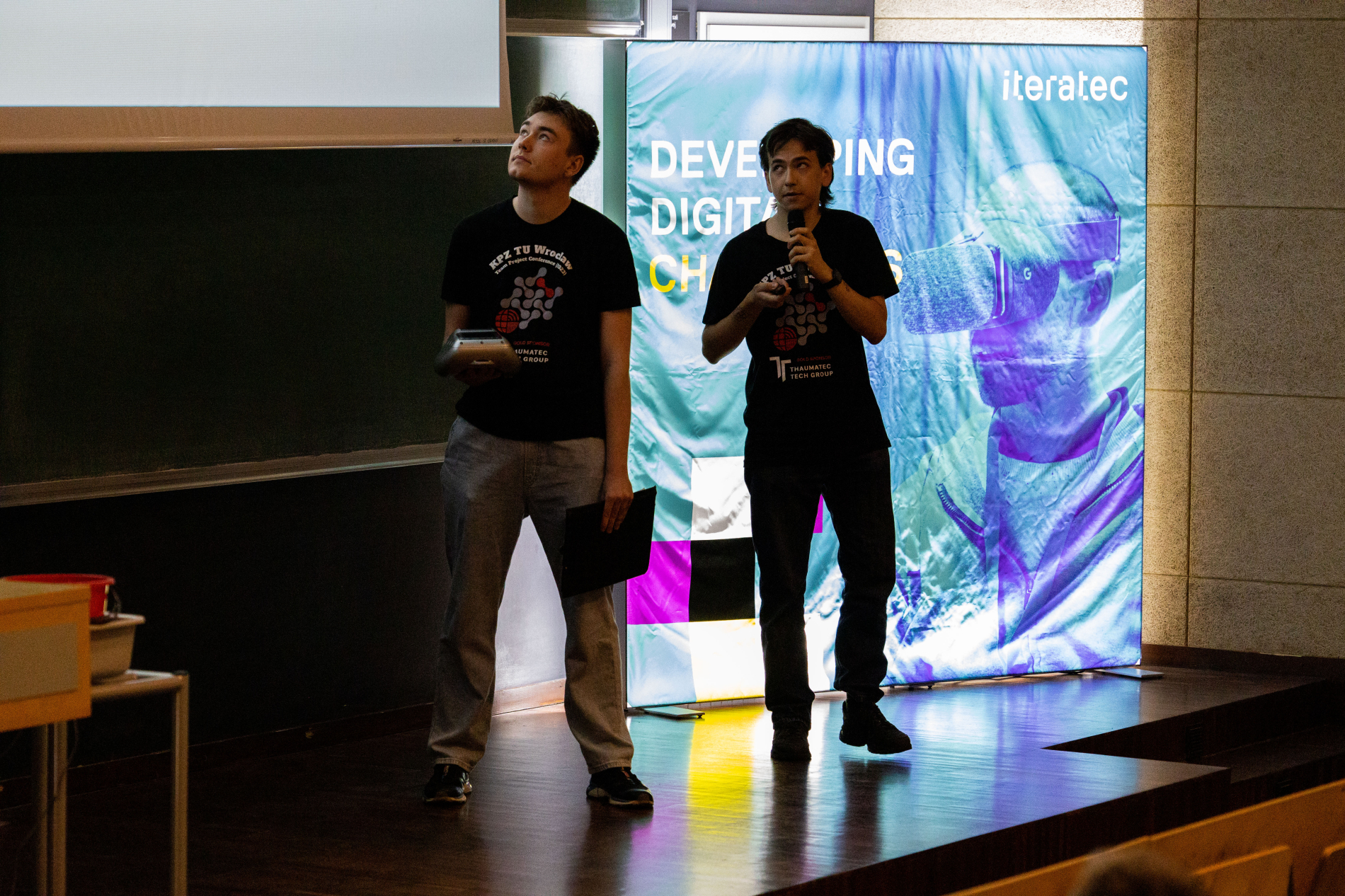 – We completed the entire project in four months. At the beginning we focused on the software for the microcontroller and on the website. Then it was time to develop the 3D print. In the future, our solution can be extended with additional sensors or GPS functionalities. You can also increase energy efficiency so that the station can work longer, – explains Hubert Orda.
– We completed the entire project in four months. At the beginning we focused on the software for the microcontroller and on the website. Then it was time to develop the 3D print. In the future, our solution can be extended with additional sensors or GPS functionalities. You can also increase energy efficiency so that the station can work longer, – explains Hubert Orda.
The solution developed by students from W12 won the best project award in the voting among representatives of companies participating in the program. The second place was taken by the project of thought-controlled augmented reality glasses, and more precisely by the Brain Computer Interface class device (BCI) reacting to brain activity, which was submitted by Comarch.
The audience award went to the "Bicycle fitter" application – which guides the user through the process of the so-called Bikefitting, i.e. the selection of individual settings and the correct position on the bike.
Where the hedgehog wanders...
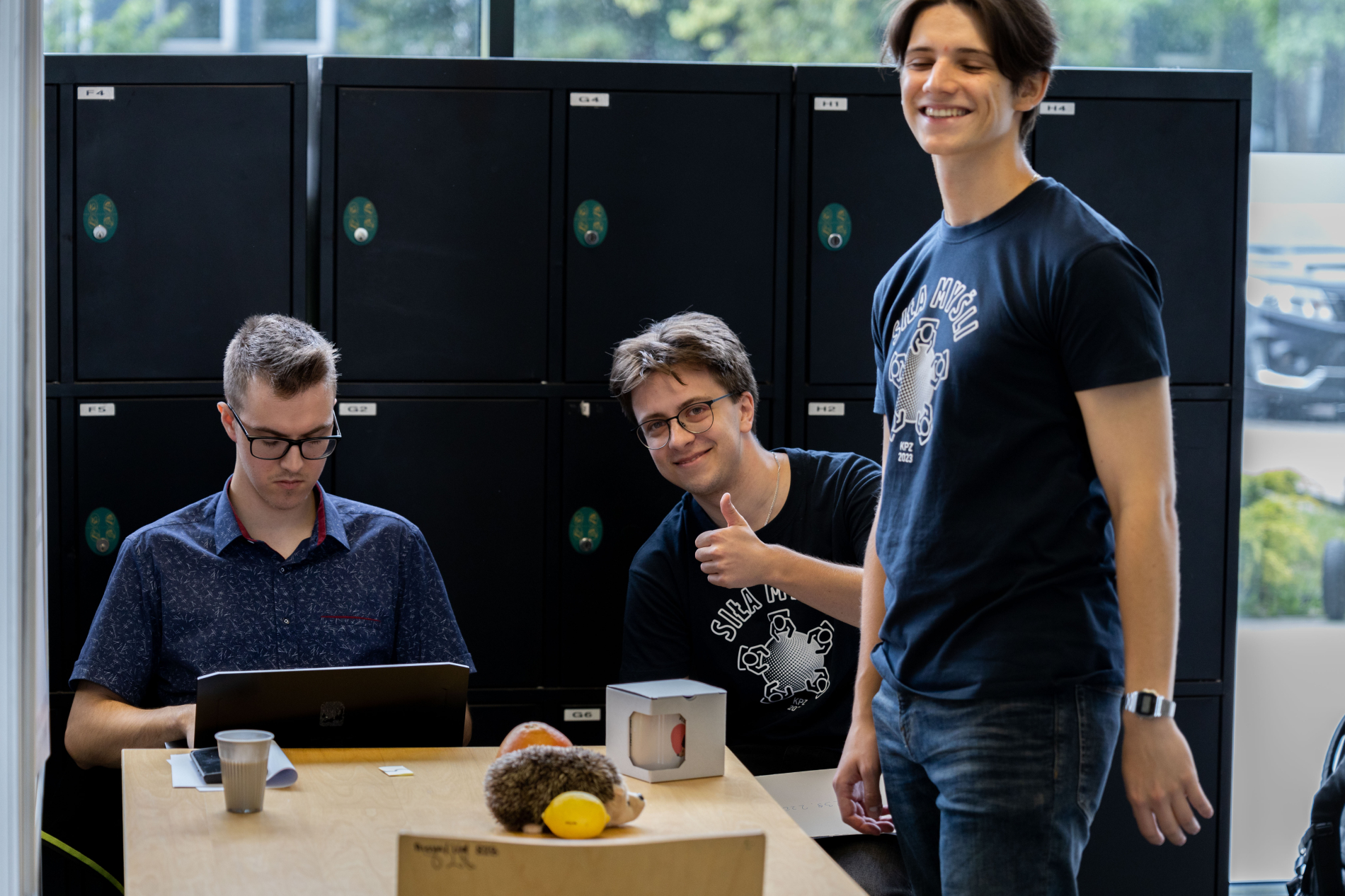 Another interesting solution was an application for monitoring the migrations of hedgehogs, developed in cooperation with iterac and the Ekostraż Wrocław Animal Protection Association. It was developed by Ernest Majewski, Kacper Krupiński, Szymon Leja, Adam Tokarski and Piotr Wilk, Technical Computer Science students at the Faculty of Information and Communication Technology.
Another interesting solution was an application for monitoring the migrations of hedgehogs, developed in cooperation with iterac and the Ekostraż Wrocław Animal Protection Association. It was developed by Ernest Majewski, Kacper Krupiński, Szymon Leja, Adam Tokarski and Piotr Wilk, Technical Computer Science students at the Faculty of Information and Communication Technology.
– Our solutions allow the user to easily provide information about a hedgehog that may need help. It’s enough to provide the exact location, briefly describe the condition of the hedgehog and possibly add a photo. The notification goes directly to Ekostraż, which can immediately intervene – explains Ernest Majewski.
Owing to the description and the photo, volunteers working in the association can quickly assess the condition of the animal, but also monitor the behaviour of hedgehogs in a given area and their activity, even at unusual times of the day.
– It was a big challenge in the project to prepare the interface in such a way that the notification could be sent as soon as possible, and at the same time that it contained all the information needed by Ekostraż. The focus was on providing help immediately – adds Ernest Majewski.
The application covers the entire Lower Silesia. A similar solution has been implemented, for example, in Great Britain, and in 2019 in Kraków a one-off action was carried out to create a hedgehog activity map.
Sign language interpreter
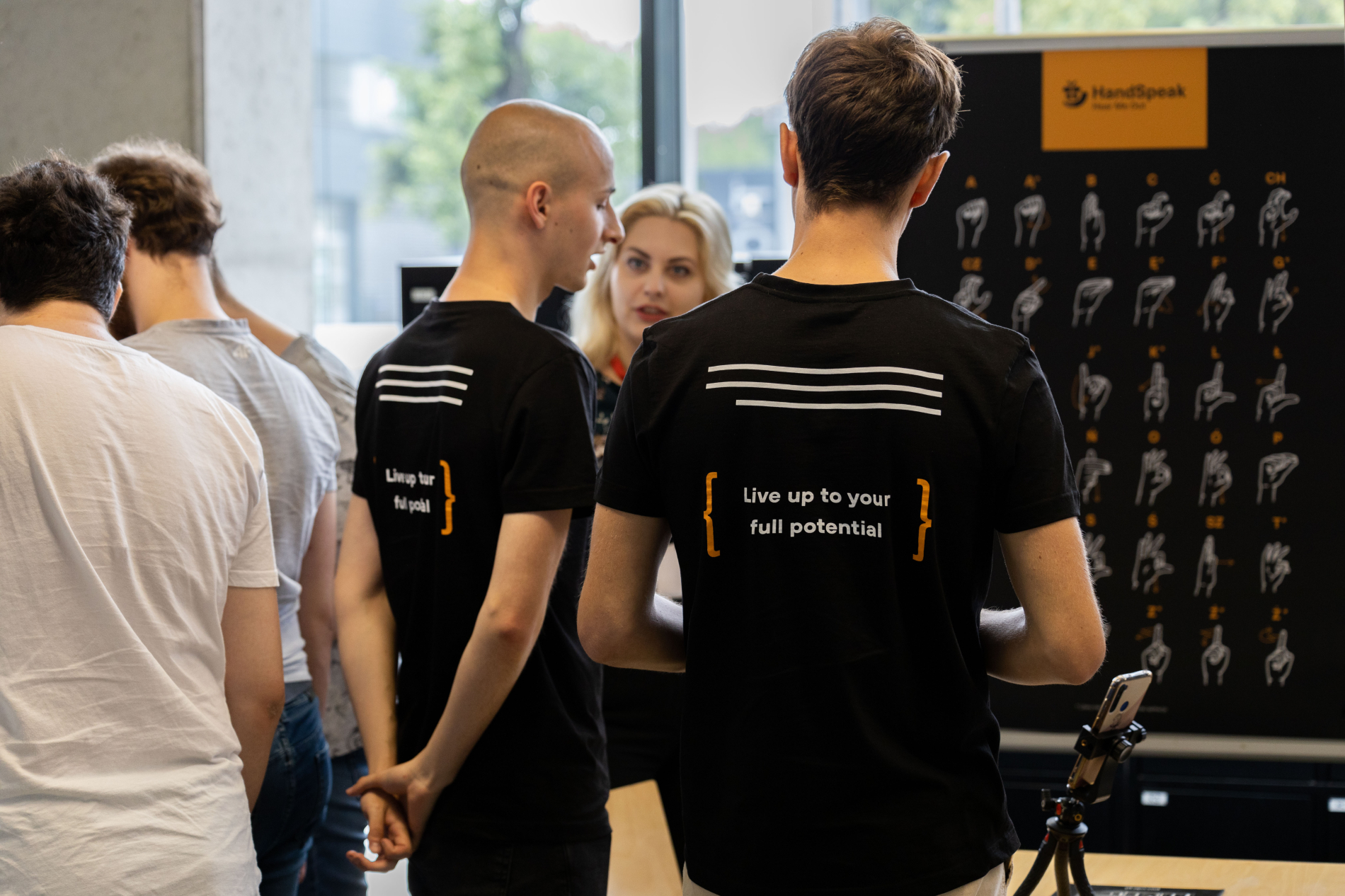 The application that recognizes and translates sign language in real time made an impression on the audience. The project was proposed by estigiti and developed by Adrianna Zimoch, Adam Modlich, Bartłomiej Kempa, Maciej Hołodniuk and Karol Janowski – students of Automation and Robotics at W12.
The application that recognizes and translates sign language in real time made an impression on the audience. The project was proposed by estigiti and developed by Adrianna Zimoch, Adam Modlich, Bartłomiej Kempa, Maciej Hołodniuk and Karol Janowski – students of Automation and Robotics at W12.
– We chose this project because it addresses the exclusion of people using sign language, which is a current problem. Our application uses a neural network model that allows you to recognize signs made by hands captured by the phone camera, interpret them and save them as a string of letters – explains Maciej Hołodniuk.
Students admit that the biggest challenge was finding useful training data, because Polish Sign Language is not universal and has users only in our country. Finally, appropriate data were found on the Harvard University website, where a large, over 2 GB photo database had been published.
– It was on that database that we trained our neural network. We do not support more complex letters, e.g. ź and ż yet, because showing them requires several sequences of movements, but the rest of the letters are recognized with a very decent efficiency – adds Maciej Hołodniuk.
In the future, the students would like to expand their application with an educational mode and introduce a functionality allowing the recognition of entire words, so that the application could do its job even better.
See the old Wrocław
 Estigiti proposed one more project to the students – a mobile application for exploring pre-war Wrocław. It was developed by Tymoteusz Rawicki, Ilia Liubin and Raman Skuratovich, students of Automation and Robotics at W12, and their solution allows you to see what some famous buildings in Wrocław looked like 100 years ago.
Estigiti proposed one more project to the students – a mobile application for exploring pre-war Wrocław. It was developed by Tymoteusz Rawicki, Ilia Liubin and Raman Skuratovich, students of Automation and Robotics at W12, and their solution allows you to see what some famous buildings in Wrocław looked like 100 years ago.
– The topic is related to history, which I am passionate about. I like looking through old photos and I wanted to carry out a project that would let me feel the atmosphere of those times – says Ilia Liubin. – Our application uses an augmented reality tool. After pointing the phone camera at a given building, three-dimensional objects are superimposed on it. In this case they are the shapes of former Wrocław buildings. Importantly, you can walk around them, and the image can be zoomed in and out as you wish – he adds.
At this stage, the students have mapped the Feniks department store and the St. Magdalena church. Thanks to the application, we can see the illuminated globe that used to crown the corner tower of the department store building and the spires on the church, which are no longer there today.
– Mapping one model takes about 30 hours, but it is not difficult. Any enthusiast who gets to know the software can prepare such a model and share it with us, and we will add it to the application – explains Tymoteusz Rawicki.
The students plan to add three more objects: the C-19 building, which housed the former children's hospital at Hoene-Wrońskiego st., the B-1 building at Smoluchowskiego 25 st. and the Grunwaldzki Bridge.
The main sponsors of this year's edition of the event were Deloitte i PPG Global Business Services Poland, and the Gold sponsors were iteratec and Thaumatec Tech Group.
